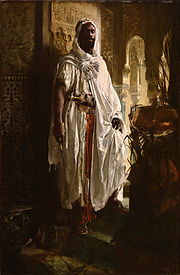Synopsis
Act I

On a shore on the coast of Granada, Maria, the orphan ward of Velez, reaffirms her fidelity to Velez's son, Albert, who is missing. Velez urges the case for his other son, Osorio, the younger brother of Albert, but Maria dislikes Osorio. Velez believes Albert is dead because of Osorio's (false) report that he witnessed Albert's ship founder in a storm after it was captured as a prize by a Moorish pirate. [5]
Velez and Maria are interrupted by Francesco, an inquisitor, who has arrested and imprisoned a Moresco, Ferdinand, on suspicion of relapsing to Islam. Alhadra, the Moorish wife of Ferdinand, pleads for Osorio to intervene on his behalf. Osorio declares he will question Ferdinand. He then departs, followed by Francesco and Velez. [6]
Albert enters disguised as a Moor and wearing forbidden Moorish garments. He has been ‘loitering’ in the area for three weeks with a view to arousing the pain of remorse in Osorio and Maria for jointly plotting to have him murdered. When he encounters Maria, she fails to recognise him. Under the veil of a dream account, Albert relates the attempt on his life by a hired assassin. Maria's reaction to his account suggests to Albert that she was innocent of the assassination plot. [7]
Act II
After arranging Ferdinand's release from prison, Osorio asks Ferdinand to trick Maria using a mock incantation to convince her that Albert is dead. Ferdinand was the assassin hired by Osorio to kill Albert. Osorio, convinced of Albert's death, is persuaded by Ferdinand to ask the "stranger" to trick Maria instead. Ferdinand relates how the stranger (the disguised Albert) has identified himself as "He that can bring the dead to life again". [8]
Osorio goes to Albert's cottage and fails to recognise his disguised brother. He demands that Albert perform a fraudulent séance before Maria in which her portrait, which Albert used to wear around his neck, materialises. Osorio obtained the portrait from Ferdinand as proof of Albert's assassination. Osorio "returns" the portrait to Albert so that it can be used in the "dark trick". This will convince Maria that Albert is dead and encourage her to accept Osorio as husband. [9]
Act III
Albert performs his act of sorcery before Maria, Velez and Osorio. Instead of using the portrait of Maria, however, Albert reveals a picture he has painted of his own assassination. Albert does this to show Osorio that his scheme to have his brother killed is known. Maria swoons and Velez is delighted by what he regards as a harmless manoeuvre by Osorio to convince Maria of Albert's death. Upon seeing the painting of Albert's assassination, Osorio immediately assumes that he has been betrayed by Ferdinand. He allows Francesco to imprison Albert for his sacrilegious act of sorcery. [10]
Act IV
Osorio confronts Ferdinand in a dark cavern. The two men fight with swords before Ferdinand is disarmed and hurled down a chasm by Osorio to die. [11]

In the court before Velez's castle, Maria and her Foster-Mother discuss the stranger (Albert). The Foster-Mother recounts a tale of a baby boy found by a woodman. The boy was a wild child of nature but became a learned youth. He was imprisoned for heresy but escaped to the New World where it is believed "he lived and died among savage men". The tale awakens sympathy within Maria for the imprisoned Albert. Velez condemns Maria for stubbornly refusing Osorio, and Francesco suggests that Maria should enter a convent. Maria's response is to mock Francesco's faith and oppressive behaviour. [12]
At night, Alhadra and her cohort of Moors meet in the mountains. In defiance of the Christian laws, they wear Moorish garments and proclaim their adherence to Mahomet. Alhadra reveals to the group that she followed Ferdinand to the cave and, after seeing Osorio leave the scene, entered the cave to hear Ferdinand's death groan in the chasm. She calls on the group to avenge his death. [13]
Act V
Alhadra and the Moors capture Francesco but are prevented from killing him by Albert's companion, Maurice, who has joined the group. Alhadra and the Moors then proceed to the castle of Velez. [14]
In the dungeon, Osorio visits Albert and reveals a tortured sense of remorse for Albert's disappearance. Maria enters with the intention of helping Albert escape and Albert finally reveals himself to Osorio. Although Osorio begs for forgiveness, he nevertheless craves punishment for his crimes. When Alhadra enters, Osorio openly admits to murdering Ferdinand, whereupon he is dragged away and killed by the Moors. [15]













